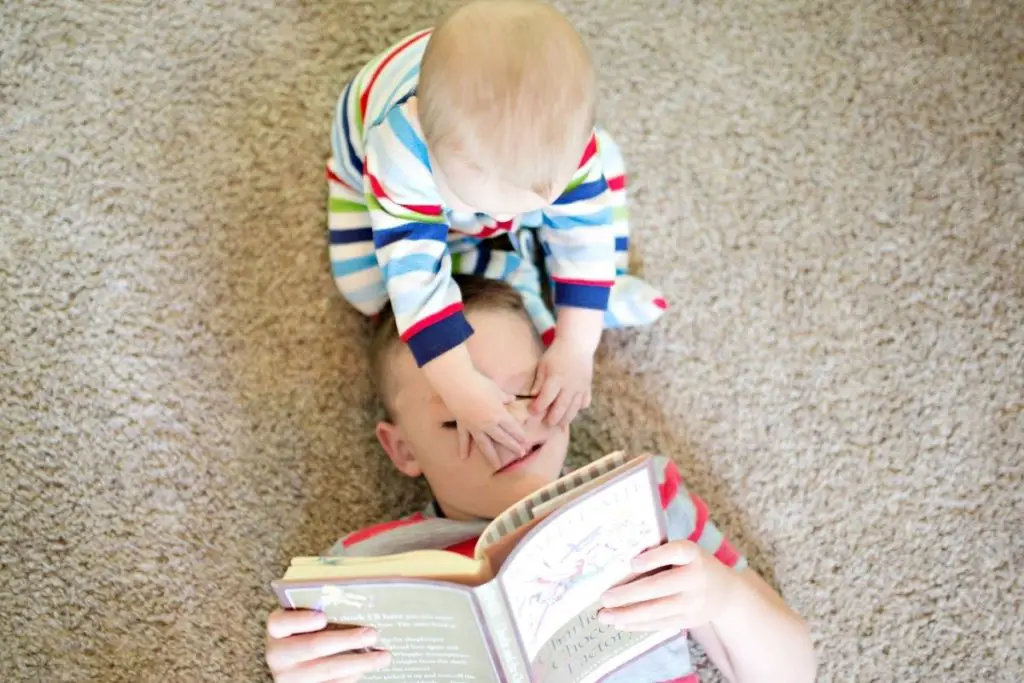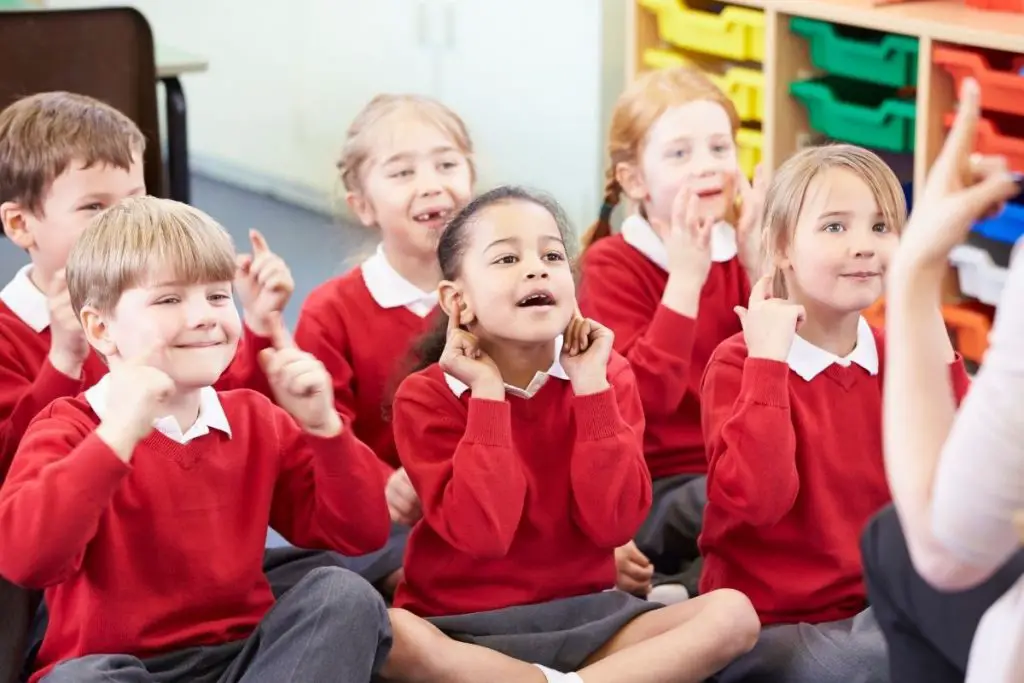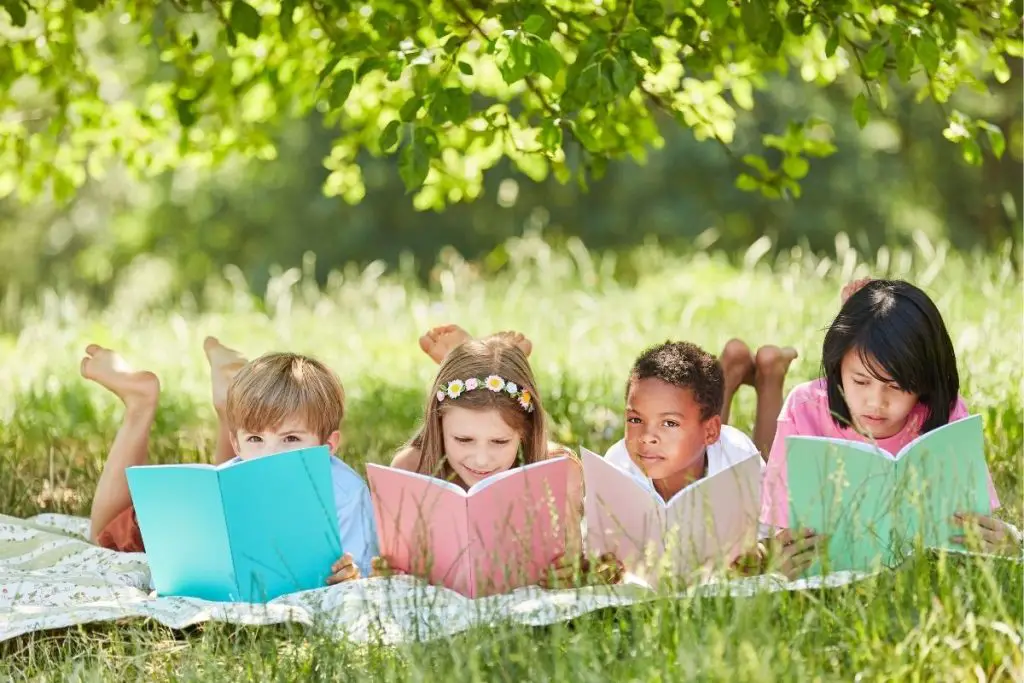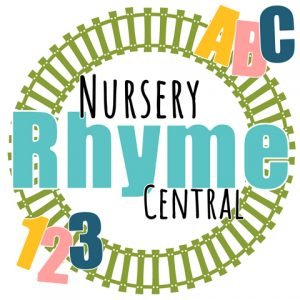‘Aren’t nursery rhymes the same as fairy tales’ my husband asked casually? ‘No’ I exclaimed a little too forcefully, ‘they are not the same at all!’ ‘Same diff’, was basically his reply. Well now my husband wasn’t too concerned with why they were different, but for me the difference between them is huge and for me, it matters, and so I thought I should investigate and research their differences a little more by writing this article!
Nursery rhymes are different from fairy tales for several reasons. Firstly, nursery rhymes are usually poems, while fairy tales are narratives. Secondly, nursery rhymes contain far fewer words than most fairy tales and are suitable for short attention spans. Thirdly, many nursery rhymes have a musical component that fairy tales lack.

Research shows that nursery rhymes stimulate young children in a way that fairy tales don’t. Nursery rhymes promote the acquisition of motor skills, speech and music appreciation and strengthen various types of memory. They encourage the development of neural pathways and connectivity in the brain.
The Differences Between Fairy Tales and Nursery Rhymes
The following table explains the differences between fairy tales and nursery rhymes and I go into more detail about each point a bit further on.
| Fairy Tales | Nursery Rhymes |
|---|---|
| Narratives or stories. | Poems or lyrics. |
| Long in length | Short in length |
| Are Read | Are Said |
| Encourage storytelling | Encourage pre-literary skills |
| Strengthen visualization. | Strengthen Gross Motor Skills. |
| For preschoolers and up. | For babies, toddlers, and preschoolers |
1. Fairy tales narratives, Nursery Rhymes are Poems
Fairy tales require an understanding of a series of events while nursery rhymes don’t. Many fairy tales are lessons in morality and other complex topics, while nursery rhymes tend to be soothing, educational, fun, simple, superficially innocent, and free of moral judgment. However, this doesn’t mean that their role in the culture of a society is simple.
Young children take time to learn to follow a narrative as it means having to remember many different parts of a story. -for example being able to retell the beginning, the middle and end, the characters, setting and more to have a good understanding and appreciation of the story. Young children understand and appreciate nursery rhymes much more easily. The music, verse, and pattern of a nursery rhyme are as important to a young child as the actual words.
2. Fairy Tales are Long, Nursery Rhymes are Short
Nursery rhymes are far more compact than fairy tales, and don’t require long attention spans, and convey short, rich messages in only a few words. Human beings relate to the rhythm and meter of poetry instinctively, at an almost unconscious level. When combined with a simple tune as many are, nursery rhymes provide multi-dimensional contact points for the mind, unlike fairy tales.

3. Fairy Tales are Read, Nursery Rhymes are Said!
Nursery rhymes are mainly orally taught to children, whereas fairy tales are read or told. A child hearing a fairy tale is not usually required to recite or re-tell it to someone else, unlike a nursery rhyme. As children acquire reading skills, they can enjoy reading fairy tales for themselves. Indeed, fairy tales encourage the acquisition of these skills, but nursery rhymes play a valuable role in the earlier, pre-literate stages of child development.
Nursery rhymes are not intended to encourage reading as much as learning words, nouns, verbs, simple concepts, numbers, sequences, and objects the child will encounter in their everyday environment. That said, young children exposed to nursery rhymes early in life seem to acquire reading skills more easily than those that aren’t.
4. Fairy Tales Encourage story telling, Nursery Rhymes encourage pre-literary skills.
Nursery rhymes encourage the exploration and pronunciation of new words without paying much attention to their meaning. They create simple mental imagery that isn’t always logically or rationally connected. Many nursery rhymes represent a type of memory training for systems and concepts encountered in everyday life.
5. Fairy Tales encourage visualization, Nursery Rhymes encourage Gross Motor Skills
Nursery rhymes are often accompanied by physical enactments such as sitting down, jumping up, raising hands, etc. As such, they provide play and role-playing opportunities. They introduce numeracy, scale, size, and sequence to a young child. Many adults can still cite the familiar nursery rhyme for remembering how many days are in each month and will do so mentally when asked to answer a question in this regard.
5. The audience.
Every poem, story, lyric, or any other piece of oral or written prose has an audience. Fairy tales although they can be read to toddlers and babies are enjoyed more by older children who can sit and appreciate the intricacies of the story. For example, Little Red Riding Hood was not written for babies or toddlers, rather for children around the age of Little Red herself. Whereas nursery rhymes are created to entertain, educate or calm babies, toddlers, and preschoolers who require simpler language, rhythms, music, and movement to help keep them engaged. It is true that ‘the wheels on the bus’ is thoroughly enjoyed by six-year-olds, but you will start to notice complaints of – this is too babyish as children become older than this unless asked to sing to younger siblings or children.

The Similarities between Fairy Tales and Nursery Rhymes
Some of the biggest similarities between fairy tales and nursery rhymes are:
- they are both created for children
- they are made for entertainment
- they promote literary skills
- they can be used to teach children in a fun way
Because they do have several similarities, especially the fact they fairy tales and nursery rhymes are commonly thought of as being part of the children’s genres, it is easy to see why people like my husband get confused and do not see how they are more different then the same, and that these differences matter especially when using them in an educational context!
The Importance of Nursery Rhymes
Experts in child development and literacy say that if a child knows eight nursery rhymes by rote by the age of four, they are usually among the best readers at the age of eight. Mastering nursery rhymes helps a child develop memory, hear, speak, feel and move to patterns. The capacity of the human mind to detect and identify patterns is crucial for acquiring verbal, numerical, and musical knowledge, amongst others.
Nursery rhymes may offer a limited sequence of events in some cases but, more often than not, create a series of mental images whose rational links are not that obvious. They appeal to the subconscious mind rather than the conscious and don’t necessarily contain ordered time sequences or causally or spatially related events.
Although a nursery rhyme may superficially tell a story, it is unnecessary to understand the story to appreciate the verse.
- The very young children at whom nursery rhymes are aimed often recite them without being too conscious of what they are saying. Many nursery rhymes are nonsensical, even dream-like, and can appeal to youngsters who are still learning to speak. They don’t require an ordered or developed consciousness regarding concepts of morality, time, space, or cause and effect to enjoy.
- Language development studies have highlighted the importance of sensitivity to the rhythms of speech, and there is evidence that nursery rhymes can support a child’s language development. Children love rhymes and some will actively choose books with rhyming text over others. Some studies indicate that a child’s awareness of rhyme in the early years is predictive of ease in acquiring reading skills.
- The reason behind the rhyme does not have to be appreciated to relate to it. This is evidenced by the fact that many nursery rhymes have disturbing or even shocking origins that underpin their innocence which you can read about in our article the Fascinating Secret Meanings Behind Nursery Rhymes here. Even as adults, many people aren’t aware of the sometimes dark origins of certain nursery rhymes that they sang or chanted as children.
Nursery rhymes assist with developing verbal memory in young children and expand their vocabulary in a fun, accessible way through their association with music and poetry
- Nursery rhymes are a way to create and enrich an appreciation and love of language in a young child where the brain is still developing. It is often a case of language for language’s sake rather than conveying complex and subtle meanings.
This does not mean adults cannot appreciate nursery rhymes as a body of literature with significant links to historical and cultural events and beliefs. Many adults fondly remember even in old age, nursery rhymes they could recite as small children, and their recall is almost effortless. Nursery rhymes embed the culture of a society in the minds of children from an early age.

- They are succinct ways of presenting archetypes and passing on a tradition. They serve an initiatory function into ways of life and thought that are definitive of culture and contain many layers of meaning that can be appreciated by old and young. The persistence of nursery rhymes through generations is indicative of their success as teaching and learning aids.
For instance, Humpty Dumpty, at its most literal, teaches that if you sit on a wall or other high place, you might fall off and injure yourself. It also introduces children to the fragility of eggs with shells that can crack and the idea that something can be irretrievably broken. It could even offer an age-appropriate lesson on gravity, depending on how it is taught.
Some Nursery Rhymes are designed to teach the names of colors, numbers, letters, and the days of the week, while others may contain a short sharp moral lesson.
- Others engage the mind in a riddle or puzzle or encourage the correct pronunciation of more complex words. All are usually meant to be chanted or sung, enabling the shaping of young lips, tongues, and vocal cords in new ways. One of the oldest nursery rhymes is Pat-a-cake, pat-a-cake baker’s man. It is usually accompanied by hand-clapping between two children or a child and an adult, which encourages hand-eye coordination and motor skills. It also explains a little about baking a cake.
The rhyme, Ding dong bell, Pussy’s in the well, explains the importance of not being cruel to cats or animals in general. (What a naughty boy to try to drown poor pussy cat). It also mentions that cats play a valuable role in keeping the mice from the farmer’s barn. So it is educational concerning cats and contains a moral lesson against animal cruelty, invoking sympathy for cats.
- Some nursery rhymes explain parts of the body or physical processes in a playful way that is easy to remember for example in the rhyme heads, shoulders, knees, and toes we sing about and touch different parts of the body.
Others explain causation, provide mental scaffolding on which new concepts can be hung, or introduce the subject of mortality. The nursery rhyme, I’m a little teapot, teaches the parts of a teapot using accompanying actions or the rain washes Itsy Bitsy spider down the water spout he was climbing.
Hey Diddle, Diddle introduces entertaining mental imagery of animals doing surprising things, but also verbs and prepositions (the cow jumped over the Moon and the Dish ran away with the Spoon). The rhyme beginning, one, two, three, four five, once I caught a fish alive, teaches counting.

Nursery rhymes are beneficial in helping young children to pronounce difficult words or phrases, improving their speech abilities. They teach intonation, exciting or funny words, and interjections.
- Language awareness and music awareness are also learned through nursery rhymes. They reinforce different memory circuits by connecting them. The knowledge of nursery rhymes is an important precursor and determinant of later literacy. The ability of young children to recite nursery rhymes has proven to be related, directly and indirectly, to subsequent literacy and language abilities. It provides a significant opportunity to interact with peers and parents.
- Nursery rhymes also encourage the development of a young child’s listening and phonetic skills and attention span. They give the child an opportunity to practice modulating their voice in terms of volume, pitch, and inflection. The rhymes inculcate an awareness of patterns and worldviews that help a child relate to and integrate with the greater society of which they are a member.
An important distinction between a nursery rhyme and a fairy tale is that the former introduces a child to music, and music aids brain development.
- Nursery rhymes don’t overload a child with information but present it in bite-sized chunks that are easy to recall and mentally stimulating. Music contains auditory, emotional, and visual stimuli that encourage the development of neural networks in children.
Speaking and hearing language generally stimulates brain activity in the left hemisphere only. In contrast, research shows that listening to music activates almost every part of the brain across both hemispheres. Hearing a familiar song increases brain activity. Performing music stimulates even more brain activity, and melody contours, phrasing, pitch intervals, and harmony can assist a child’s language development more fully than mere word repetition and rhythm alone.
Nursery rhymes encourage –
- the acquisition of basic language concepts
- the acquisition of speech and vocal skills
- understanding of linguistic patterns, tone, and rhythms
- musical appreciation
- physical development of the brain
- the development of motor skills
The Importance of Fairy Tales
Fairy tales often offer an escape to an imaginary world in which the importance of rules is usually emphasized. These rules may be practical, like obeying your mother, or moral, like not telling lies. They introduce concepts like gender roles, romance, beauty, courage, perseverance, truth, fairness, loyalty, good and evil, greed, and time.
Fairy tales are for older minds compared to Nursery Rhymes and can provide a basic psychological toolkit for dealing with life’s challenges and adversity.

- They are usually intended for older children who understand causation, the passage of time, and the sequential nature of events and have a large enough vocabulary to appreciate the words of the story. Fairy tales have profound psychological meanings and significantly impact the consciousness of the reader or hearer. There is a mythic quality to fairy tales that is absent from nursery rhymes. Fairy tales encourage more mature readers to explore mythology which provides an enriching cultural experience.
- Fairy tales offer more distinct lessons in history, morality, culture, tradition, and folk wisdom than nursery rhymes. These features are generally appreciated by children at higher developmental levels than toddlers and infants. Very young children may not have a sufficient attention span to listen to a fairy tale and are unable to read them independently. However, they don’t have to be able to read to learn a nursery rhyme and can quickly learn to sing or chant those for themselves.
Fairy tales teach children about life, help them understand and deal with fear, love, insincerity of others, encourage good decisions, discourage bad ones, explain that bad things sometimes happen to good people or that not everyone is trustworthy. They show a child that things might not be as they first appear.
- The Ugly Duckling story is more relevant than ever in today’s world, where children are bullied, shunned, or mistreated because they don’t fit in. It teaches them that not all who are different are bad and that childhood problems can resolve in adulthood as they grow and develop to maturity. It also teaches self-acceptance, and that beauty is only skin deep.
- Little Red Riding Hood warns of stranger danger and the importance of not trusting everyone implicitly. The wolf has bad intentions, while the woodcutter is good.
- The Emperor’s New Clothes encourages a child to speak the truth when everyone else is in denial or refusing to see it. The child knows that even though a fairy tale is not real, there is an underlying truth to it applicable in the real world.
- Pinocchio teaches that you cannot achieve your heart’s desire by telling lies and that honesty is valued in society and relationships.
Counselors and therapists can use fairy tales to help children identify and express emotions such as aggression, anxiety, jealousy, shame, and fear.
- The therapeutic use of fairy tales is not restricted to children as it is also used with adults in some contexts. Fairy tales spur a child’s imagination and enrich their capacity to fantasize. Imagination is essential for anticipating the outcomes of choices before they are acted out and for developing a person’s inner world.
- Fairy tales promote interest in literature, mythology, beauty, and reading. They develop attention span, vocabulary, and appreciation of plot sequences in stories.
Why the difference between Nursery Rhymes and Fairy Tales matters!
Understanding the different roles of nursery rhymes and fairy tales highlights the benefits to be derived from them at various stages of child development. Nursery rhymes are especially important for babies and pre-school children. They can significantly assist in acquiring motor skills, speech, reading skills, musical ability, and a lifelong desire to learn from a very early age. Fairy tales are for older children who can grasp their meaning and the moral lessons they often teach.
References:
WEBSITES:
https://www.pacey.org.uk/news-and-views/pacey-blog/
https://news.arizona.edu/blog/
https://www.researchgate.net/publication/320332692_Relationship_Between_Young_Children’s_Nursery_Rhyme_Experiences_and_Knowledge_and_Phonological_and_Print-Related_Abilities
https://www.booktrust.org.uk/news-and-features/features/2018/november/rhymes-in-early-childhood/
https://thegeniusofplay.org/genius/play-ideas-tips/play-ideas/patacake.aspx#.YH04p6mA4TU
https://www.pacey.org.uk/news-and-views/pacey-blog/october-2019/the-importance-of-nursery-rhymes-in-early-childhoo/
https://digitalcommons.calpoly.edu/cgi/viewcontent.cgi?article=1076&context=musp
DOCUMENTS & RESEARCH ARTICLES:
https://files.eric.ed.gov/fulltext/ED442117.pdf
https://hilo.hawaii.edu/campuscenter/hohonu/volumes/documents/ThePositiveImpactsofFairyTalesforChildrenLeilaniVisikoKnox-Johnson.pdf
BOOKS:
Robert Carter, The Tao, and Mother goose: A Quest Book
Lauren A Gonzalez’ Music and Language Development: Traits of Nursery Rhymes and Their Impact on Children’s Language Development’.

